Hermi Halloween
CONTEXT AND SIGNIFICANCE
In the spirit of Halloween, my project partner and I decided to make an interactive Halloween decoration. We thought about it after our lesson on rotation motors as it meant we could have movements interacting with kids trick or treating. Our project specifically pleased me because it was broad enough to be able to start from a simple creation, using basic LEDs and motors and as we moved along in our creation process we could add difficulty and more technicalities. In my understanding, interaction is a repetitive process between two agents, with an action and a response, in such way it is a prolongation of our senses through means of advancing technology. Our project fits my definition as we aimed for kids to walk up to a house on halloween and depending on the distance, some sort of interaction would happen between them and the decoration. As we thought more about interaction, we came up with using the distance sensors, in theory when the kid is for instance 2-5meters away, Hermi would start waving and his eyes would be green, and as the kid approaches, Hermi would wave faster and his eyes would turn green.
- CONCEPTION AND DESIGN:
We started bringing our Halloween decoration by designing it, we wanted him to look friendly and not scary despite the horror theme of halloween as our target audience were kids, and the goal of halloween decoration is to invite kids to come to the house. We decided to make him using the laser cuter machine as it would enable us to choose and design how we wanted him to look.
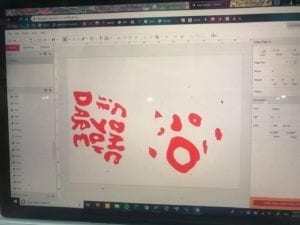

As our design was finalised, I started sketching how it would work on the technical side of things: what material we would need, where we would put them, how it would work together, so I made a rough draft in such way of his front and back:
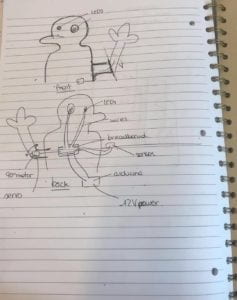
FABRICATION AND PRODUCTION:
Following the conception and design process, I decided to focus on the circuit part of things by using tinkercad.com while my project partner focused on the laser cutting design as we could not be two on one computer designing, we thought it would be more time efficient.
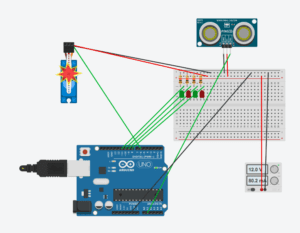
As we can see from this photo, tinkercad helped us design our circuit as it told us when there would be a short circuit so we were able to make modifications accordingly. On this picture for instance, we thought we were going to need a 12V input in order to make all the LEDs, motor and sensor work, however the 5V were sufficient, hence the short circuit on the motor shown by the red and yellow star.
Tinkercad also enabled me to start writing a code that would be the guideline for the real code on Arduino:
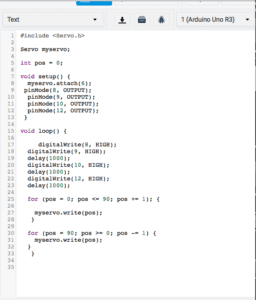
We then glued support to our foundation and soldered our LED’s as we needed to make them longer to reach the eyes:

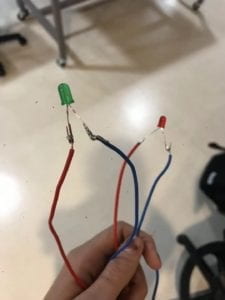
And proceed to building the circuit using a micro servo instead of the big servo and short LEDs first in order to make it as simple and check that our code would work.
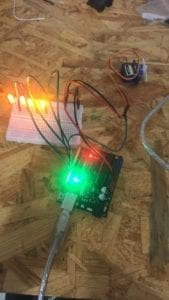
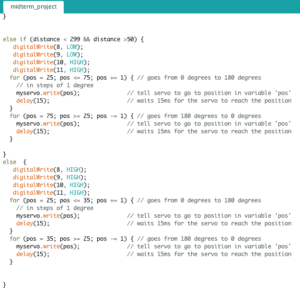
We then ran into a few technical difficulties such as finding the right angle servo which would not do full rotations, but actually make the angles which we coded as seen below, and also for reasons yet to be understood by TAs and professors, our Arduino board would not connect to our computer for hours which made us quite late on our schedule.
Came the user-testing session, we did not have time to glue the right servo to the arm, so we used a micro servo and a piece of paper so that testers would understand the purpose.
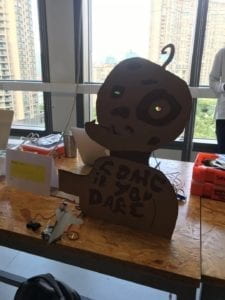
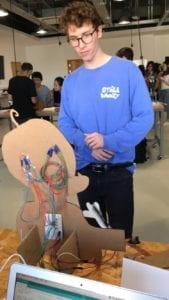
We retrieve many useful feedbacks in the user-testing session. From seeing people’s reaction to Hermi, we realised that the sensor would have to be moved because people would be drawn to his face and wave their hands in front of his eyes when the sensor was below on the table which we proceeded to change by hiding the sensor in a created bow tie made out of cardboard. Feedbacks such as adding sound, making the jaw drop, making Hermi scarier we attempted over the weekend but we ran into similar technical complications as our code would not upload on our Arduino for hours on. We tried to ask many teachers and TAs as to why that was, but none figured out what was wrong, since a few hours later it started working again, and then the same issue would occur. Despite our best efforts to fix the issue such as adding tape around wires in case there was a shortcut, fixing the code and such, this issue was time consuming and so we decided to not add sound as we could not test wether it was working as our new code would not upload. Instead, we worked on changing the delay of reaction for when Hermi detected the change in position of the users in order to make it faster and be more effective, paint his body part, make his bow tie and attach his arm and balance him so that he could stand without us holding.
By then, the project was finalised and worked effectively during the presentation.
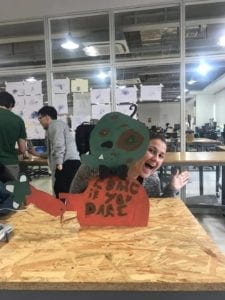
- CONCLUSIONS:
In conclusion, we achieved our goal of making a friendly halloween decoration that would invite kids to come to houses for trick or treating. Overall, potential improvements could be made in the future to create more contrast using the infrared distance sensor such as adding sound, or making Hermi immobile and then suddenly move when they approach, but due to the technical difficulties, not related to coding or circuiting as our Arduino board would simply not work, we were unable to make those changes that we wanted which is upsetting for creators but has to be accepted as it is part of the experience. We valued having a working project over one which had many ambitions but was not working by the deadline so made our decisions based on our priorities.
I think the designing aspect of a project is one of the most efficient, as the physical aspect of it accounted for a lot as it is an interaction project, the users first interact with the device by seeing it, so the fact that we worked a lot on the design, the laser cutting, and making the body parts work accordingly with the interaction accounted for a lot. Indeed, if the design of the project is not appealing, or the cardboard is obviously there and not painted over, then it does not seem finish and that will affect the interaction of the user and the device. This is mostly important as our project had for goal to entertain, and therefore needed to be entertaining to look at and seem professional, which we achieved.